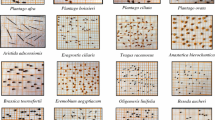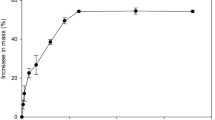Abstract
The indigenous forage grasses Lasiurus scindicus and Panicum turgidum are candidate species for the restoration of degraded desert rangelands. The impact of five dormancy regulating chemicals on overcoming salinity-induced germination inhibition was assessed under the best germination conditions in the two species. Seeds were germinated in a series of NaCl concentrations: 0–200 mM NaCl for P. turgidum, and 0–300 mM NaCl for L. scindicus. Lasiurus scindicus seeds were more tolerant to salinity than those of P. turgidum. Twenty percent of P. turgidum seeds germinated in 100 mM NaCl and none in the higher levels, but 47.5% and 8.8% of L. scindicus seeds germinated in 100 and 200 mM NaCl, respectively. The five studied chemicals (fusicoccin, GA3, kinetin, nitrate and thiourea) did not succeed in improving germination of non-saline treated seeds of the two species, compared to the control, except thiourea in P. turgidum. The salinity-induced germination inhibition in P. turgidum was completely alleviated by the application of gibberellic acid (GA3), partially alleviated by the application of fusicoccin, kinetin and thiourea, but not affected by nitrate. In L. scindicus, the germination inhibition was completely alleviated by fusicoccin, GA3, nitrate and thiourea, but partially alleviated by kinetin. For using the two grass species in restoration of degraded rangelands affected by higher salinity, the results suggest using fusicoccin, GA3, nitrate and thiourea with L. scindicus and GA3 with P. turgidum seeds as a preseeding treatment can overcome the problem of reduced germination.
Similar content being viewed by others
References
Al-Khateeb SA (2006) Effect of salinity and temperature on germination, growth and ion relations of Panicum turgidum Forssk. Bioresour Technol 97:292–298
Al-Shamsi N (2009) Germination ecology of two indigenous range grasses Lasiurus scindicus and Panicum turgidum. M Sc thesis, UAE University, Al-Ain
Badger KS, Ungar IA (1989) The effects of salinity and temperature on the germination of the inland halophyte Hordeum jubatum. Can J Bot 67:1420–1425
Baskin JM, Baskin CC (2004) A classification system for seed dormancy. Seed Sci Res 14:1–16
Bewley JD, Black M (1994) Seeds: physiology of development and germination. Plenum Press, New York
Breen CM, Everson C, Rogers K (1997) Ecological studies on Sporobolus virginicus (L.) Kunth with particular reference to salinity and inundation. Hydrobiologia 54:135–140
Debez A, Chaibi W, Bouzid S (2001) Effect of NaCl and growth regulators on germination of Atriplex halimus L. Cah Agri 10:135–138
El-Keblawy A (2004) Salinity effects on seed germination of the common desert range grass, Panicum turgidum. Seed Sci Technol 32:873–878
El-Keblawy A (2006) Overcoming innate dormancy and determination of germination requirements of economic salt tolerant native plants of the UAE. In: The proceeding of the 7th annual conference for research funded by UAE University. United Arab Emirates, Al-Ain, pp SCI 97–107
El-Keblawy A, Al-Ansari F, Al-Rawai A (2005) Effects of dormancy regulating chemicals on innate and salinity induced dormancy in the invasive multipurpose Prosopis juliflora (Sw.) DC. Shrub. Plant Growth Regul 46:161–168
El-Keblawy A, Rao MV, Al-Marzouqi A, Al Neyadi SS (2009) Germination ecology of indigenous Cyprus conglomeratus seeds: A sand dune binder. In: The proceeding of the tenth annual conference for research funded by UAE University, United Arab Emirates, Al-Ain, pp 111–120
El-Keblawy A, Al-Ansari F, Al-Shamsi N (2010) Effects of Temperature and Light on Salinity Tolerance during Germination of the two Desert Glycophytic Grasses Lasiurus scindicus and Panicum turgidum. Under publication, Forage and Grass Science
Esashi Y, Ohara Y, Okazaki M, Hishinuma K (1979) Control of cocklebur seed germination by nitrogenous compounds: Nitrite, nitrate, hydroxylamine, thiourea, azide, and cyanide. Plant Cell Physiol 20:349–361
Gul B, Weber DJ (1998) Role of dormancy relieving compounds and salinity on the seed germination of Allenrolfea occidentalis. Ann Bot 82:555–562
Gulzar S, Khan MA (2002) Alleviation of salinity-induced dormancy in perennial grasses. Biol Plantarum 45:617–619
Hester MW, Mendelssohn IA, McKee KL (1998) Intraspecific variation in salt tolerance and morphology in Panicum hemitomon and Spartina alterniflora (Poaceae). Int J Plant Sci 159:127–139
Ismail AMA (1990) Germination ecophysiology in populations of Zygophyllum qatarense Hadidi from contrasting habitats: effect of temperature, salinity and growth regulators with special reference to fusicoccin. J Arid Environ 18:185–194
Kabar K (1987) Alleviation of salinity stress by plant growth regulators on seed germination (Hordeum distichum). J Plant Physiol 128:179–183
Kabar K, Baltepe S (1989) Effect of kinetin and gibberellic acid in overcoming high temperat ure and salinity (NaCl) stresses on the germination of barely and lettuce seeds. Phyton 30:65–74
Khan AA (1977) Seed dormancy: changing concepts and theories. In: Khan AA (ed) The physiology and biochemistry of seed dormancy and germination. Elsevier, North-Holland Biomedical Press, Amsterdam, pp 29–50
Khan A, Gul B (2006) Halophyte seed germination. In: Khan MA, Weber DJ (eds) Ecophysiology of high salinity tolerant plants. Springer, Netherlands, pp 11–30
Khan MA, Gulzar S (2003) Germination responses of Sporobolus ioclados: a potential forage grass. J Arid Environ 53:387–394
Khan MA, Ungar IA (1984) The effect of salinity and temperature on the germination of polymorphic seeds and growth of Atriplex triangularis Willd. Am J Bot 71:481–489
Khan MA, Ungar IA (1996) Effects of light, salinity and thermoperiod on the seed germination of halophytes. Can J Bot 75:835–841
Khan MA, Ungar IA (2001a) Alleviation of salinity stress and the response to temperature in two seed morphs of Halopyrum mucronatum (Poaceae). Aust J Bot 49:777–783
Khan MA, Ungar IA (2001b) Effect of germination promoting compounds on the release of primary and salt-enforced seed dormancy in the halophyte Sporobolus arabicus Boiss. Seed Sci Technol 29:299–306
Khan MA, Ungar IA (2001c) Seed germination of Triglochin maritima as influenced by salinity and dormancy relieving compounds. Biol Plantarum 44:301–303
Khan MA, Gul B, Weber DJ (2001) Seed germination characteristics of Halogeton glomeratus. Can J Bot 79:1189–1194
Kucera B, Cohn MA, Leubner-Metzger G (2005) Plant hormone interactions during seed dormancy release and germination. Seed Sci Res 15:281–307
Lombardi T, Fochetti T, Onnis A (1998) Germination of Briza maxima L. seeds: effects of temperature, light, salinity and seed harvesting time. Seed Sci Technol 26:463–470
Mayer AM, Poljakoff-Mayber A (1975) The germination of seeds. Pergamon Press, The Macmillan Co, New York
Mohammad N (1989) Rangeland management in Pakistan. Senior Fellowship Series, Kathmandu, Nepal
Noor M, Khan MA (1995) Factors affecting germination of summer and winter seeds of Halopyrum mucronatum under salt stress. In: Khan MA, Ungar IA (eds) Biology of salt tolerant plants. Karachi Department of Botany, University of Karachi, Karachi, pp 51–58
Peacock JM, Ferguson ME, Alhadrami GA, McCann IR, Al Hajoj A, Saleh A, Karnik R (2003) Conservation through utilization: a case study of the indigenous forage grasses of the Arabian Peninsula. J Arid Environ 54:15–28
Perez T, Moreno C, Seffino LG, Grunber A, Bravo Z (1998) Salinity effects on the early development stages of Panicum coloratum: Cultivar differences. Grass Forage Sci 53:270–278
Poljakoff-Mayber A, Somers GF, Werker E, Gallagher A (1994) Seeds of Kosteletzkyz virginica (Malvaceae): their structure, germination and salt tolerance. Am J Bot 81:54–59
Shahba MA, Qian YL, Lair KD (2008) Improving Seed Germination of Saltgrass under Saline Conditions. Crop Sci 48:756–762
Tobe K, Zhang LP, Qiu GYY, Shimizu H, Omasa K (2001) Characteristics of seed germination in five non-halophytic Chinese desert shrub species. J Arid Environ 47:191–201
Ungar IA (1978) The effect of salinity and hormonal treatments on growth and ion uptake of Salicornia europaea. Societe Botanique de France, Actualities Botaniques 125:95–104
Yadav MS (1997) Pasture establishment techniques. In: Yadav MS, Singh M, Sharma SK, Tewari JC, Burman U (eds) Silvipastoral systems in arid and semi-arid ecosystems. Jodhpur, pp 193–206
Yadav MS, Rajora MP (1999) Technology for seed production. In: Faroda AS, Joshi NL, Kathju S, Kar A (eds) Management of arid ecosystem. Arid Zone Research Association of India and Scientific Publishers, Jodhpur, pp 333–338
Acknowledgments
The authors are grateful to Tom Heller, Royal Botanical Garden, Kew, London, for his critical revision of the manuscript.
Author information
Authors and Affiliations
Corresponding author
Rights and permissions
About this article
Cite this article
El-Keblawy, A., Al-Ansari, F. & Al-Shamsi, N. Impact of dormancy regulating chemicals on salinity induced dormancy in Lasiurus scindicus and Panicum turgidum: two desert glycophytic grasses. Plant Growth Regul 62, 163–170 (2010). https://doi.org/10.1007/s10725-010-9501-x
Received:
Accepted:
Published:
Issue Date:
DOI: https://doi.org/10.1007/s10725-010-9501-x




